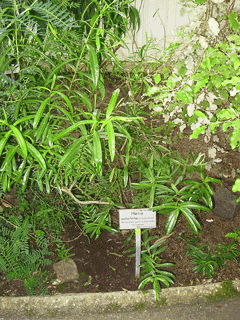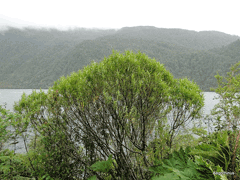 |
|
|
 |
| http://picasaweb.google.com/lh/photo/IANmgsRFji_b0NmYlYdAag |
Translate this page:
Summary
Physical Characteristics

 Hebe salicifolia is an evergreen Shrub growing to 4.5 m (14ft) by 3 m (9ft).
Hebe salicifolia is an evergreen Shrub growing to 4.5 m (14ft) by 3 m (9ft).
See above for USDA hardiness. It is hardy to UK zone 7. It is in leaf all year, in flower from June to August. The species is hermaphrodite (has both male and female organs) and is pollinated by Bees.
Suitable for: light (sandy) and medium (loamy) soils, prefers well-drained soil and can grow in nutritionally poor soil. Suitable pH: mildly acid, neutral and basic (mildly alkaline) soils and can grow in very alkaline soils.
It cannot grow in the shade. It prefers moist soil. The plant can tolerate maritime exposure.
It can tolerate atmospheric pollution.
UK Hardiness Map
US Hardiness Map
Synonyms
Veronica salicifolia.
Plant Habitats
Hedge;
Edible Uses
References More on Edible Uses
Medicinal Uses
Plants For A Future can not take any responsibility for any adverse effects from the use of plants. Always seek advice from a professional before using a plant medicinally.
Antispasmodic Dysentery
Treats dysentery, having an antiperistaltic action[153].
References More on Medicinal Uses
The Bookshop: Edible Plant Books
Our Latest books on Perennial Plants For Food Forests and Permaculture Gardens in paperback or digital formats.

Edible Tropical Plants
Food Forest Plants for Hotter Conditions: 250+ Plants For Tropical Food Forests & Permaculture Gardens.
More

Edible Temperate Plants
Plants for Your Food Forest: 500 Plants for Temperate Food Forests & Permaculture Gardens.
More

More Books
PFAF have eight books available in paperback and digital formats. Browse the shop for more information.
Shop Now
Other Uses
Hedge Hedge
A very wind resistant shrub, it can be grown as a shelter hedge in exposed maritime positions. Attractive flowers.
Special Uses
Food Forest Hedge Hedge
References More on Other Uses
Cultivation details
Succeeds in most soils so long as they are not boggy or too dry[182]. Prefers a light well-drained soil[1, 166] and a sunny position[200]. Prefers a moist rich soil[166] but plants are probably hardier in a soil that is on the poor side[1]. Lime tolerant[11]. Intolerant of drought[166]. Tolerates atmospheric pollution[200]. Very wind resistant, withstanding maritime exposure[166]. A polymorphic species[200[, it hybridizes freely with other members of this genus. Plants in this genus are notably resistant to honey fungus[200]. In garden design, as well as the above-ground architecture of a plant, root structure considerations help in choosing plants that work together for their optimal soil requirements including nutrients and water. The root pattern is clumping, giving the plant a clumping habit. The predictable growth behaviour makes it easier to maintain without having to apply containment methods[2-1].
References Carbon Farming Information and Carbon Sequestration Information
Temperature Converter
Type a value in the Celsius field to convert the value to Fahrenheit:
Fahrenheit:
The PFAF Bookshop
Plants For A Future have a number of books available in paperback and digital form. Book titles include Edible Plants, Edible Perennials, Edible Trees,Edible Shrubs, Woodland Gardening, and Temperate Food Forest Plants. Our new book is Food Forest Plants For Hotter Conditions (Tropical and Sub-Tropical).
Shop Now
Plant Propagation
Seed - we have no information on this species but suggest sowing the seed in a greenhouse in spring. Only just cover the seed and do not allow the compost to dry out. Prick out the seedlings into individual pots when they are large enough to handle. Grow on the young plants for at least their first winter in a greenhouse and plant out in late spring or early summer after the last expected frosts. It would probably be worthwhile giving some protection to the plant for its first winter outdoors. Cuttings of half ripe wood, 3 - 5cm with a heel, July/August in a frame. Pot up when roots are forming and keep in a frame or greenhouse for its first winter before planting out in late spring. Cuttings of mature wood, late autumn or winter in a frame.
Other Names
If available other names are mentioned here
Native Range
SOUTHERN AMERICA: Chile AUSTRALASIA: New Zealand
Weed Potential
Right plant wrong place. We are currently updating this section.
Please note that a plant may be invasive in one area but may not in your area so it's worth checking.
Conservation Status
IUCN Red List of Threatened Plants Status :

Growth: S = slow M = medium F = fast. Soil: L = light (sandy) M = medium H = heavy (clay). pH: A = acid N = neutral B = basic (alkaline). Shade: F = full shade S = semi-shade N = no shade. Moisture: D = dry M = Moist We = wet Wa = water.
Now available:
Food Forest Plants for Mediterranean Conditions
350+ Perennial Plants For Mediterranean and Drier Food Forests and Permaculture Gardens.
[Paperback and eBook]
This is the third in Plants For A Future's series of plant guides for food forests tailored to
specific climate zones. Following volumes on temperate and tropical ecosystems, this book focuses
on species suited to Mediterranean conditions—regions with hot, dry summers and cool, wet winters,
often facing the added challenge of climate change.
Read More
Expert comment
Author
(G.Forst.)Pennel.
Botanical References
1144200
Links / References
For a list of references used on this page please go here
Readers comment